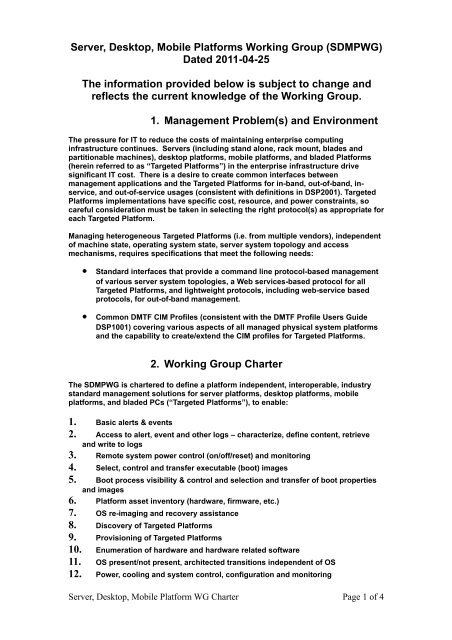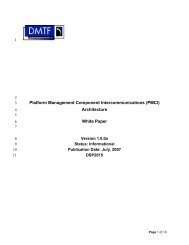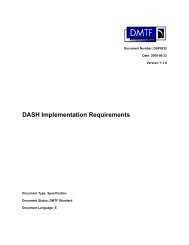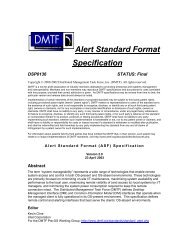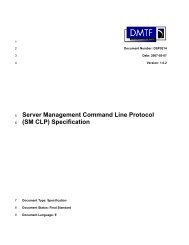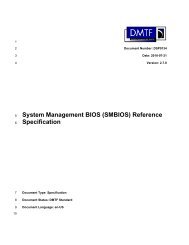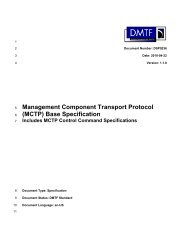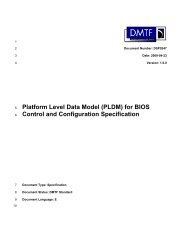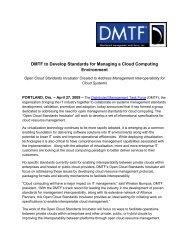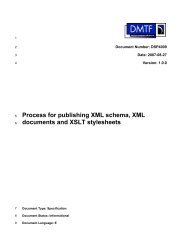Physical Platform Profiles Working Group - DMTF
Physical Platform Profiles Working Group - DMTF
Physical Platform Profiles Working Group - DMTF
You also want an ePaper? Increase the reach of your titles
YUMPU automatically turns print PDFs into web optimized ePapers that Google loves.
Server, Desktop, Mobile <strong>Platform</strong>s <strong>Working</strong> <strong>Group</strong> (SDMPWG)<br />
Dated 2011-04-25<br />
The information provided below is subject to change and<br />
reflects the current knowledge of the <strong>Working</strong> <strong>Group</strong>.<br />
1. Management Problem(s) and Environment<br />
The pressure for IT to reduce the costs of maintaining enterprise computing<br />
infrastructure continues. Servers (including stand alone, rack mount, blades and<br />
partitionable machines), desktop platforms, mobile platforms, and bladed <strong>Platform</strong>s<br />
(herein referred to as “Targeted <strong>Platform</strong>s”) in the enterprise infrastructure drive<br />
significant IT cost. There is a desire to create common interfaces between<br />
management applications and the Targeted <strong>Platform</strong>s for in-band, out-of-band, inservice,<br />
and out-of-service usages (consistent with definitions in DSP2001). Targeted<br />
<strong>Platform</strong>s implementations have specific cost, resource, and power constraints, so<br />
careful consideration must be taken in selecting the right protocol(s) as appropriate for<br />
each Targeted <strong>Platform</strong>.<br />
Managing heterogeneous Targeted <strong>Platform</strong>s (i.e. from multiple vendors), independent<br />
of machine state, operating system state, server system topology and access<br />
mechanisms, requires specifications that meet the following needs:<br />
• Standard interfaces that provide a command line protocol-based management<br />
of various server system topologies, a Web services-based protocol for all<br />
Targeted <strong>Platform</strong>s, and lightweight protocols, including web-service based<br />
protocols, for out-of-band management.<br />
• Common <strong>DMTF</strong> CIM <strong>Profiles</strong> (consistent with the <strong>DMTF</strong> Profile Users Guide<br />
DSP1001) covering various aspects of all managed physical system platforms<br />
and the capability to create/extend the CIM profiles for Targeted <strong>Platform</strong>s.<br />
2. <strong>Working</strong> <strong>Group</strong> Charter<br />
The SDMPWG is chartered to define a platform independent, interoperable, industry<br />
standard management solutions for server platforms, desktop platforms, mobile<br />
platforms, and bladed PCs (“Targeted <strong>Platform</strong>s”), to enable:<br />
1. Basic alerts & events<br />
2. Access to alert, event and other logs – characterize, define content, retrieve<br />
and write to logs<br />
3. Remote system power control (on/off/reset) and monitoring<br />
4. Select, control and transfer executable (boot) images<br />
5. Boot process visibility & control and selection and transfer of boot properties<br />
and images<br />
6. <strong>Platform</strong> asset inventory (hardware, firmware, etc.)<br />
7. OS re-imaging and recovery assistance<br />
8. Discovery of Targeted <strong>Platform</strong>s<br />
9. Provisioning of Targeted <strong>Platform</strong>s<br />
10. Enumeration of hardware and hardware related software<br />
11. OS present/not present, architected transitions independent of OS<br />
12. Power, cooling and system control, configuration and monitoring<br />
Server, Desktop, Mobile <strong>Platform</strong> WG Charter Page 1 of 4
13. Access to sensor data, including presence, temperature and other sensors.<br />
14. Access to logs – characterize, define content, retrieve and write<br />
15. View and set status indicators (LED, text LCD, alarms etc.)<br />
16. Configuration of service processors and their components/services.<br />
17. Media & KVM redirection<br />
18. Correlation of multiple Management Access Points (MAP)<br />
19. OS recovery assistance<br />
20. Access to security information, such as accounts, groups and security<br />
modules<br />
21. Network Interface monitoring and control including wired and wireless.<br />
22. IO interconnect technologies such as PCI, SMBus, Bluetooth, USB and other<br />
interconnects.<br />
By performing the following tasks:<br />
• Define an architectural model for Targeted <strong>Platform</strong> management<br />
• Leverage <strong>DMTF</strong> protocols and identify lightweight management stack(s)<br />
suitable for out-of-band management<br />
• Define platform independent, interoperable, industry standard management<br />
data models, profiles and registries for the aspects of managing the physical<br />
aspects of system platforms that are within the scope of the management<br />
solutions described above.<br />
• Define mechanisms for secure management<br />
• Define mechanisms for scalable management<br />
• Define mechanisms for scalable discovery & correlation<br />
The SDMPWG will also own the following tasks related to its area of focus:<br />
• Definition of the <strong>DMTF</strong> Management Initiative DASH<br />
• Definition of the <strong>DMTF</strong> Management Initiative SMASH<br />
• Work with the System Management Forum (SMF) to develop a compliance<br />
program for DASH & SMASH<br />
Examples of physical system platforms include, but are not limited to:<br />
• desktop platforms<br />
• mobile platforms<br />
• bladed PCs<br />
• Servers spanning the spectrum of:<br />
• Stand alone, blades, racks and partitionable systems<br />
• Enterprise & Telco<br />
• Low cost to mission critical<br />
In the course of authoring profiles, the WG will identify schema additions and<br />
modifications as necessary and work with the Schema Sub-Committee to incorporate<br />
these changes.<br />
The focus of the WG is management of Targeted <strong>Platform</strong>s for in-band, out-of-band, inservice,<br />
and out-of-service (consistent with definitions in DSP2001) environments. This<br />
includes interactions with the operating system that are necessary to assist in<br />
hardware management. Direct management of a running operating system and its<br />
associated applications is out of scope.<br />
The Server, Desktop, Mobile <strong>Platform</strong>s WG reports to the <strong>Platform</strong> Management<br />
Subcommittee.<br />
Alliance Partnerships<br />
• SNIA (Storage Networking Industry Alliance: Storage Management Initiative)<br />
Server, Desktop, Mobile <strong>Platform</strong> WG Charter Page 2 of 4
• TCG (Trusted Computing <strong>Group</strong>)<br />
• TGG (The Green Grid)<br />
• CompTIA (Computing Technology Industry Association)<br />
• Consortium for Service Innovation<br />
• SA Forum (Service Availability Forum)<br />
• Blade Systems Alliance<br />
• UEFI<br />
3. Reliance/Coordination with other WG<br />
Models<br />
The SDMPWG will work closely with all of the <strong>Working</strong> <strong>Group</strong>s and sub-committees under the<br />
TC.<br />
4. Prior Work<br />
2.<br />
3. DSP0217 SMASH Implementation Requirements<br />
4. DSP0232 DASH Implementation Requirements<br />
5. DSP0244 IPMI PET-to-CIM Message Registry Mapping Specification<br />
6.<br />
7. DSP0800 Base Server Profile SM CLP Command Mapping Specification<br />
8. DSP0801 CLP Service Profile SM CLP Command Mapping Specification<br />
9. DSP0802 SMASH Collections Profile SM CLP Command Mapping<br />
Specification<br />
10. DSP0803 SM CLP Admin Domain Profile SM CLP Command Mapping<br />
Specification<br />
11. DSP0804 Modular System Profile SM CLP Command Mapping<br />
Specification<br />
12. DSP0805 Sensors Profile SM CLP Command Mapping Specification<br />
13. DSP0806 Device Tray Profile SM CLP Command Mapping Specifications<br />
14. DSP0807 Pass-Through Module Profile SM CLP Command Mapping<br />
Specification<br />
15. DSP0808 CPU Profile SM CLP Command Mapping Specification<br />
16. DSP0809 System Memory Profile SM CLP Command Mapping<br />
Specification<br />
17. DSP0810 Record Log Profile SM CLP Command Mapping Specification<br />
18. DSP0811 Simple Identity Management Profile SM CLP Command Mapping<br />
Specification<br />
19. DSP0812 <strong>Physical</strong> Asset Profile SM CLP Command Mapping Specification<br />
20. DSP0813 Boot Control Profile SM CLP Command Mapping Specification<br />
21. DSP0814 Fan Profile SM CLP Command Mapping Specification<br />
22. DSP0815 Ethernet Port Profile SM CLP Command Mapping Specification<br />
23. DSP0816 Host LAN Network Port Profile SM CLP Command Mapping<br />
Specification<br />
24. DSP0817 IP Interface Profile SM CLP Command Mapping Specification<br />
25. DSP0818 DHCP Client Profile SM CLP Command Mapping Specification<br />
26. DSP0819 DNS Client Profile SM CLP Command Mapping Specification<br />
27. DSP0820 Telnet Service Profile SM CLP Command Mapping Specification<br />
28. DSP0821 SSH Service Profile SM CLP Command Mapping Specification<br />
29. DSP0822 Power Supply Profile SM CLP Command Mapping Specification<br />
Server, Desktop, Mobile <strong>Platform</strong> WG Charter Page 3 of 4
30. DSP0823 Power State Management Profile SM CLP Command Mapping<br />
Specification<br />
31. DSP0824 Chassis Manager Profile SM CLP Command Mapping<br />
Specification<br />
32. DSP0825 Shared Device Management Profile SM CLP Mapping<br />
Specification<br />
33. DSP0826 Software Inventory Profile SM CLP Command Mapping<br />
Specification<br />
34. DSP0827 Software Update Profile SM CLP Command Mapping<br />
Specification<br />
35. DSP0828 Text Console Redirection Profile SM CLP Command Mapping<br />
Specification<br />
36. DSP0830 Role Based Authorization Profile SM CLP Command Mapping<br />
Specification<br />
37. DSP0831 <strong>Platform</strong> Watchdog Profile SM CLP Command Mapping<br />
Specification<br />
38. DSP0834 Computer System Profile SM CLP Command Mapping<br />
Specification<br />
39. DSP0835 Indicator LED Profile SM CLP Command Mapping Specification<br />
40. DSP0836 KVM Redirection Profile SM CLP Command Mapping<br />
Specification<br />
41. DSP0842 OS Status Profile SM CLP Command Mapping Specification<br />
42. DSP0843 Media Redirection Profile SM CLP Command Mapping<br />
Specification<br />
43. DSP0845 Base Metrics Profile SM CLP Command Mapping Specification<br />
DSP1004<br />
DSP1005<br />
DSP1006<br />
DSP1007<br />
DSP1008<br />
DSP1009<br />
DSP1010<br />
DSP1011<br />
DSP1012<br />
DSP1013<br />
DSP1014<br />
DSP1015<br />
DSP1016<br />
DSP1017<br />
DSP1018<br />
DSP1019<br />
DSP1020<br />
DSP1021<br />
DSP1022<br />
DSP1023<br />
DSP1024<br />
DSP1025<br />
DSP1026<br />
DSP1027<br />
DSP1028<br />
DSP1029<br />
DSP1030<br />
DSP1035<br />
DSP1036<br />
DSP1037<br />
Base Server Profile<br />
CLP Service Profile<br />
SMASH Collections Profile<br />
SM CLP Admin Domain Profile<br />
Modular Systems Profile<br />
Sensors Profile<br />
Record Log Profile<br />
<strong>Physical</strong> Asset Profile<br />
Boot Control Profile<br />
Fan Profile<br />
Ethernet Port Profile<br />
Power Supply Profile<br />
Telnet Service Profile<br />
SSH Service Profile<br />
Service Processor Profile<br />
Device Tray Profile<br />
Pass-Through Module Profile<br />
Shared Device Management Profile<br />
CPU Profile<br />
Software Inventory Profile<br />
Text Console Redirection Profile<br />
Software Update Profile<br />
System Memory Profile<br />
Power State Management Profile<br />
Alarm Device Profile<br />
OS Status Profile<br />
Battery Profile<br />
Host LAN Network Port Profile<br />
IP Interface Profile<br />
DHCP Client Profile<br />
Server, Desktop, Mobile <strong>Platform</strong> WG Charter Page 4 of 4
DSP1038<br />
DSP1039<br />
DSP1040<br />
DSP1052<br />
DSP1058<br />
DSP1061<br />
DSP1070<br />
DSP1074<br />
DSP1075<br />
DSP1076<br />
DSP1077<br />
DSP1085<br />
DSP1086<br />
DSP1088<br />
DSP1102<br />
DNS Client Profile<br />
Role Based Authorization Profile<br />
<strong>Platform</strong> Watchdog Profile<br />
Computer System Profile<br />
Base Desktop and Mobile Profile<br />
BIOS Management Profile<br />
Opaque Management Data Profile<br />
Indicator LED Profile<br />
PCI Device Profile<br />
KVM Redirection Profile<br />
USB Redirection Profile<br />
Power-Utilization Management Profile<br />
Media Redirection Profile<br />
WiFi Port Profile<br />
Launch In Context Profile<br />
44. DSP2001 System Management Architecture for Server Hardware<br />
Whitepaper<br />
45. DSP2014 Systems Management Architecture for Mobile and Desktop<br />
Hardware White Paper<br />
46.<br />
DSP8007<br />
DSP8021<br />
DSP8030<br />
DSP8039<br />
<strong>Platform</strong> Message Registry<br />
BIOS Attribute Registry<br />
DASH XML Schema<br />
SMASH XML Schema<br />
1. Current Work – Overview, Deliverables and<br />
Timeline<br />
• Extend existing profiles with Indications support<br />
• Deepen the functionality provided by existing profiles<br />
• Add additional profiles and SM-CLP Mapping Specifications, as needed<br />
• DSP0232 DASH Implementation Requirements<br />
• DSP2014 Systems Management Architecture for Mobile and Desktop<br />
Hardware White Paper<br />
• DSP0217 SMASH Implementation Requirements<br />
• DSP2001 SMASH White Paper<br />
• Develop Machine Readable <strong>Profiles</strong> for WG-owned profiles, as needed<br />
Chair: sdmpwg-chair@dmtf.org<br />
2. <strong>DMTF</strong> Contacts<br />
3.<br />
47. To join the <strong>DMTF</strong> and/or the WG, see<br />
http://www.dmtf.org/join/ and<br />
http://www.dmtf.org/apps/org/workgroup/sdmpwg/<br />
Server, Desktop, Mobile <strong>Platform</strong> WG Charter Page 5 of 4


